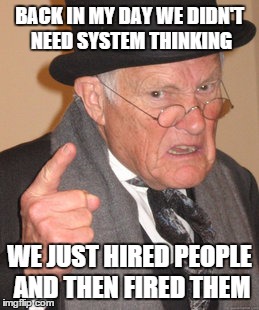 When on the Scrum Master Podcast, I was asked a very important question: How do I get a systemic view of the organization. This is worth going deeply into.
When on the Scrum Master Podcast, I was asked a very important question: How do I get a systemic view of the organization. This is worth going deeply into.
Let’s start with why this view is valuable.
The more I work with teams, I find there’s a limit of change I can make. Or, rather, they can make.
For example, working with developers, I can teach them unit testing, design practices and maybe some testing theory. But unless they are given a chance to try it (and safely fail) there’s not going to be much effect on their work.
Same goes for working with product people. If their prioritization is sound, but management keeps shifting the focus, that training won’t turn into valuable practices.
The ability of people to change is dependent on the dynamics in the organization.
The problem is that these dynamics don’t always show themselves. As time goes by, I learn more about how the organization works, and can then (mostly in hindsight) piece things together. I understand better why some experiments have failed, when others have succeeded. When I have this picture, theses dynamics become visible, and as they do, better options for improvement appear.
In addition, when we understand how the system works, we can better match expectations, and negotiate towards a jointly understood goals. Much better than be surprised, trust me.
One more point: We want to identify these dynamics quickly. Less failed experiments, and more quick wins are better for everyone.
A systemic view helps to understand the organization, the dynamics, the opportunities and the risks.
Tell me your secret
I don’t have tools or a process, but I ask a lot of questions, that clear out the fog of war. These are the topics I want to explore, and some of the questions I ask for clarification. I look for observed examples that actually happened, rather than opinions. Although the latter matter too, actual proof is better.
- Authority is the ability to follow through with the trained material.
- Who makes the decisions?
- Are the decisions enforced?
- Who is the enforcer?
- Are decisions overridden? By whom and does it happen often?
- Success and failure are often in the eye of the beholder. However, if you get enough testimonies, you get a feeling about how success is perceived.
- What is considered a success, and by whom?
- What is the affect of a successful project/endeavor/feat/act?
- Are success and failure attributed to teams or specific persons?
- What is the aftermath of a failure?
- People are the most valuable asset of the organization, as every trained executive will tell you (the guy in the picture, for example). It is very interesting to see how people get into, fit and leave the organization.
- How are people hired?
- What’s the on-boarding process?
- What’s the turnaround?
- Do people spend time together outside work?
- If people are the most valuable resource in the organization, the teams must be synergically combined to be the effective engines of the organization.
- What’s the definition of a team?
- How are teams built, by whom and when?
- How are teams collaborating?
- Are they isolated from each other?
- How self-organized are they?
- Are they collocated?
- Explaining the structure of the organization usually starts with a slide. But is that how everyone perceives that structure?
- What is the management team structure?
- How many management levels are there?
- When do people get promoted, and on what basis?
- How long has this structure been in place? And the one before that?
- There’s always more work to be done, but perception again is what matters.
- What’s the release schedule?
- How many deadlines are there? Who sets them?
- How many deadlines are met/missed? What happens when either happens?
- Do people work long hours?
- What kind of challenges do people see in the work?
- Is the work interesting?
- What kind of technology is used? Is it pushing the envelope or old legacy?
- What kind of practices are already being used? Are they effective?
- Finally, going back to square one, I’d like to see if there is alignment between work and vision, or taking it down to earth:
- Do people know how their work helps the organization?
- Why do people come to work? Is it only a job, or do they feel they work towards a bigger goal?
- What is the organization’s purpose? Does everyone answer the same answer?
All these paint a picture of the system, the actors and sets the stage for some (small) understanding of what to expect when you start making changes.
As with every transformation, there is no end point. Things change, the organization changes, and so is the systemic view. We need to keep asking these questions regularly, to keep up.
Also, even if you think you’ve figured everything out, trust me, you don’t.
But that’s a start.